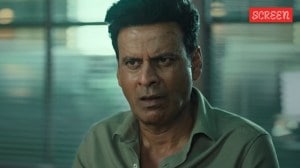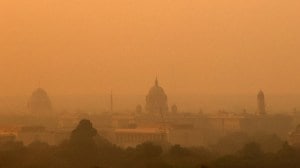On the campaign trail with Jaswant Singh
Toward the end of the campaign, the arm was limp with handshake fatigue, the familiar deep baritone was raspy, the face was lined with fa...

Toward the end of the campaign, the arm was limp with handshake fatigue, the familiar deep baritone was raspy, the face was lined with fatigue and some pain.
There had been dashes through unfamiliar territory, across crowded streets and through busy traffic, though with powerful security cars and sirens to clear the roads. The meetings had been diverse: some were brief, virtual street corner stops, after a pause to look at a note slipped by an aide to check on the issues that the constituency was concerned about; others were campaign speeches from the pulpit to the faithful and the not-so-faithful, to the supportive and the critical. There were firm handshakes, pledges of support, voices of concern and occasionally ignorant queries. There were glittering lunches and hurried bites at hotels with aides and supporters.
Everywhere, the message was the same: India is a factor for stability in the world, especially in Asia; it will not allow third-party mediation in Kashmir but is committed to human rights; itis prepared to engage in a dialogue with Pakistan, but not in haste; one of the major threats that the world faces is from the Talibanisation of Afghanistan and the instability of Pakistan; India is developing an answer to the problems of democratic succession and it is determined to move forward swiftly and aggressively on economic change and reform.
Welcome to campaigning in the greatest city in the world: New York, home to the United Nations, the New York Times (probably the world’s most powerful newspaper), new fashions, brilliant theatre and music, great restaurants and museums, the rich, the famous, the poor, the unknown, the bad and the beautiful. And no, this isn’t the Senate race between Hillary Clinton and Mayor Rudolph Guilaini, which promises to be a humdinger of a battle — though both are being coy and not announcing their candidature officially.
The campaigner here is Jaswant Singh, India’s External Affairs Minister, who was in town for the last UN General Assembly of the millennium, and hewasn’t running for office either. He was in New York to post India’s views of the world as well as its position on specific issues such as relations with Pakistan and China and international affairs (including U.N. peacekeeping and interventions). Singh set and kept a blistering pace with bilateral meetings with the foreign ministers of over 20 countries, including Britain, France, Ireland, Greece and the US. He continued with intense meetings at the Asia Society outlining India’s approach to a range of issues, a working dinner of the Indo-American Round Table, discussions with some of the most influential media figures and editorial boards in the US (including the New York Times, the Wall Street Journal and ABC).
By this time Singh’s shoulder, which had been hurting for some time, had begun to cause acute pain. A check with an orthopaedic surgeon indicated that an operation was necessary. There was concern about the campaign but Singh slipped quietly into a hospital on a Saturday morning, wasoperated upon and by the evening, wearing a shoulder brace and with his arm in a sling, walked into Ambassador Naresh Chandra’s reception for leaders of the Indian community to a standing ovation from a packed hall.
He stayed for much of the evening, refused to take the chair that was offered but spoke for nearly half an hour from a podium and took a series of questions. All this against doctor’s orders, and much to the concern of aides and senior diplomats.
What he said was not new for Indian audiences — the battles on the tortuous heights of Kargil, the bravery of the soldiers, the determination of the government, the belief that India would progress after this election because a stable government would be formed, and the need to speed up economic change. He thanked the overseas Indian community for their support during the days of Kargil, a gesture that went down well.
What really drew a response here and elsewhere, including in the interactions with the media, was Singh’s own openness and readinessto admit problems. "I get as exasperated as you do, perhaps even more," he would intone to surprised laughter from his audience about the slow pace of reforms. And he declared time and again that the gap between promise and reality, between expectation and implementation, would have to be bridged rapidly by the new government.
At the open forums, an inevitable comparison would be made between India and China: how India was slothful, slow to change and didn’t seem to move. On the other hand, the person would say, China was embracing foreign investment and was ready for the Great Leap Forward.
Singh would acknowledge that things were difficult in a democracy because of the open nature of society. A state government could oppose a central scheme or an individual or an NGO could go to court and get a stay on a project. "The process of change and development is not a 100 metre sprint, it is a marathon and we believe that India will win the marathon," he then added.At the end of an interview or a meeting, hewould turn to his aides and ask wearily, "Why can’t they ask about something other than Kashmir and our relationship with Pakistan or the nuclear programme?" He often felt unchallenged, even in his interactions with top television anchors and newspaper writers.
Every morning and evening, he would exercise his troubled arm with swings that appeared to be in the nature of golf drive practice. "I apologize, but the doctor tells me I have to do this," he told me as I walked in for an interview a couple of days after the operation. I don’t know if it reduced the pain, but he rarely let on.
But there was no option: this was a hands-on operation by the first leader of the Indian government to visit the West after the Kargil conflict to articulate India’s beliefs in a convincing manner:
That India meant business, that it was a large nation with large concerns not limited to the subcontinent, that it was serious about its role as a stabilising force in Asia — especially when compared to Pakistan, which is seenin the West as a bad investment and a seething cauldron of resentment and terrorism. Parity does not pay, the Minister underlined, referring to the often equal-handed approach by the West to India and Pakistan.
The message was repeated time and again, especially for the benefit of the media. And it went home. It was a campaign far more low-profile but as important as any being fought at home — and this was being fought not by a political party but by the government.
The New York Times applauded the elections in an editorial: "The world’s largest democracy once again set a stirring example for all nations … India’s rich diversity sometimes looks like an obstacle to unity. But the latest election has proved that a commitment to resolving differences peacefully and democratically can transform diversity into a source of strength."
(Tomorrow: In the maw of the beast)



- 01
- 02
- 03
- 04
- 05




























